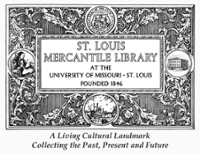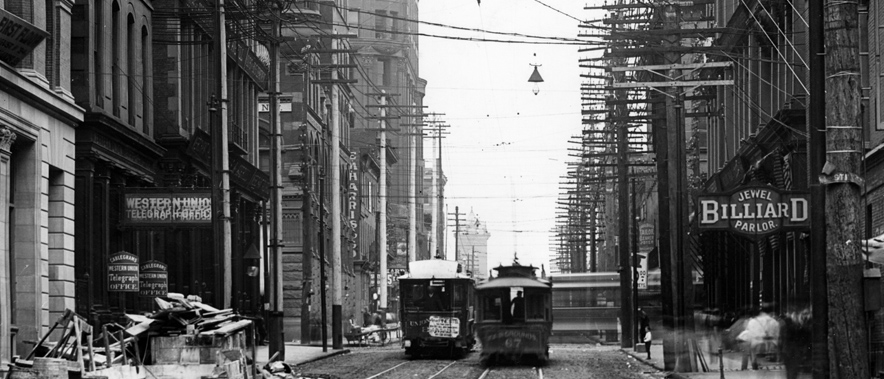Chicago/Herald Examiner
Life at the Globe
The End of the Globe
After the Globe
Chicago Herald Examiner
G. Duncan Bauman began his newspaper career in 1931, as a reporter for the Chicago Herald Examiner. He worked there for eight years and covered a wide variety of news items, from court cases, to murders, to labor strikes. The Bauman Collection contains several books of clippings of his articles. Most are about divorce and family court cases.
One of the most sensational cases Bauman worked on was that of Robert Irwin.
In 1937 Irwin murdered his girlfriend, an artist's model, her mother, and a border at the house. A week after he committed the murder he turned himself in to the Chicago Herald Examiner, who interviewed him. The Bauman Collection contains several Irwin related articles, as well as a sketch done by Irwin of Mr. Baumann.
In working for the Chicago Herald Examiner Bauman had to be ready to cover any breaking news out in the field.
At the paper Bauman learned how to get the story no matter what. His editor, Harry Romanoff, once told him, when he was having trouble getting into a building to get photos for a story, that "...either get in or don't come back" (from Bauman's Autobiography). Along with covering murders and suicides, Bauman also covered many of the strikes that happened in the 1930s. This was dangerous work. In covering the Chicago Yellow Cab and the Steel Workers strikes Bauman witnessed first hand how violent a strike could become, when he saw a striker douse a stolen cab with gasoline and then set it on fire. The Bauman Collection has several articles which cover the strikes in Chicago during the 1930s.
Life at the Globe
Among The Bauman Collection there are historic Globe-Democrat Photos from the turn-of-the-century. The photos show the printing room, editors' office, and other scenes of newspaper life at that tim
In 1943 G. Duncan Bauman took a job as a reporter at the St. Louis Globe-Democrat. One of the major stories he covered for the Globe was the first postwar ocean crossing of the luxury liner the Queen Elizabeth. Bauman wrote several stories for the Globe during this time, not only about the ocean liner, but also about England. The Bauman Collection contains several items about the Queen Elizabeth, including articles, menus, press passes, and baggage tags.
This booklet, titled "What makes the St. Louis Globe-Democrat a Great
Newspaper" was given out to those who took a tour of the Globe-Democrat.
It details the different departments, as well as the history of the paper.
Bauman was involved in many political campaigns, and supported the
conservative platform. He lent his support not only on the local level,
but also at the national one. Among the Bauman Collection are inaugural
invitations, tickets, programs, personal letters and pictures covering the
Eisenhower/Nixon, Nixon/Agnew, and Reagan/Bush campaigns.
The End of the Globe
In 1983 the St. Louis Globe-Democrat's advertising revenue was up and their daily circulation was around 60,000. In spite of this though, the newspaper was to close on December 31, 1983. Insufficient profit margins and the escalating cost of labor lead to the paper's downfall. Local St. Louis papers, including the Globe-Democrat's rival the Post-Dispatch, covered the paper's slow death from 1983 until it finally ceased publication in 1986. The Bauman Collection contains several newspaper clippings from local papers about the Globe's closing.
In 1983 when the Globe-Democrat was set to close there was an outpouring of public support for the paper. Private citizens, politicians, and local business leaders gave their support and condolences to Bauman, and the paper. Later when the paper came under new ownership employees aired their grievances to Bauman. The Bauman Collection contains many letters, from personal friends and subscribers to the paper, covering the Globe-Democrat's demise.
The closing of a 131 year old newspaper was big news, not just in St. Louis but across the country. The slow death of the paper was covered in many national publications. Several clippings from these papers are in the Bauman Collection.
After the Globe
After his retirement from the Globe-Democrat G. Duncan Bauman remained a fixture in the St. Louis area. Not only did he continue to be a member of numerous boards, but he also wrote a book of anecdotes about St. Louis taken from his career as a journalist. He also gave generously to several different organizations. He continued to keep up with the latest news in St. Louis. The Bauman collection contains several news clippings from Bauman's latter years.
In 1984 Washington University School of Law established a scholarship in his name. In 2000 Bauman established the G. Duncan Bauman Family Trust Endowment for Interdisciplinary Programs in Ethics and Leadership at Loyola University. He is quoted as saying, "No education in the world could have better prepared me for the life I have lead." With his bequest he hoped to help "just one student learn the ethical principles that helped shape my life." He also continued to work with many local organizations, such as the Variety Club. The Bauman Collection contains several articles and letters related to organizations he continued to be involved in.
In 1999 Bauman, with former Globe-Democrat staffer Mary Kimbrough, published his memoir, Behind the Headlines. The book chronicles how St. Louis coped with the challenges of urban and suburban growth, desegregation, crime, education, and health care. Bauman's book gives credit to the men and woman who made the Globe-Democrat one the the top newspapers in the nation. In the book Bauman also offers sharp criticism for the profession he loved and looks ahead to its role in the twenty-first century. There are several reviews of his book in the collection.
During this period Bauman continued to receive many awards and honors. In 1989 Bauman received the Silver Bell Award for community service from the Mental Health Association of St. Louis. In 2001 he received the Virginia Betts White Quest lifetime Award for distinguished achievement in communications. These are just two of the many plaques, awards, and metals the Bauman received over his lifetime that are in the Bauman Collection.
G. Duncan Bauman died on April 14, 2003 from heart failure at the age of 91. His collection was given to the Mercantile shortly thereafter.
Duncan Bauman Collection Main Page
In observance of security procedures, certain services may not be available shortly before the daily closing time.
Direct questions or comments regarding this site to
The Saint Louis Mercantile Library at the University of Missouri-St. Louis
Charles Brown
Reference Services,
St. Louis Subject Specialist
314.516.7243
cbrown@umsl.edu





